After writing Surf Fishing 101, I discovered that there were a lot of things that I did not cover, the big one being rigging techniques and what to use on different species. So let me take this time to introduce you to Surf Fishing 102, Rigging Techniques. The idea of this write up is to talk about the different types of rigs that I have encountered over the past few years and why I do or do not use them. Please remember, just like Surf Fishing 101, this is merely based on my opinions on what works best for me.
First I will talk about what is probably the most common rig used on the beach. It is called the fish finder rig. There are many different names and variations of this rig – sometimes called a drum rig or even a Carolina rig – but whatever you call it, they are all very similar. A fish finder or drum rig to me is basically your shock leader tied directly to a swivel, which typically has a few inches of heavy mono or wire attached directly to your hook. Now the shock leader also has a sinker slide on it that allows weight to move up and down your shock leader. The picture below is what I typically use on my heavers at the beach.
The idea behind this rig is that when a fish grabs your bait, he will be able to swim off with it in his mouth while the sinker stays put in the sand, basically so the fish feels no resistance. This gives him (or her!) plenty of time to eat the bait, or if you’re using a large chunk, to get the whole thing in his mouth. The small profile of this rig allows you to cast it further without the “helicopter” effect.
I’m going to break down the fish finder rig and explain what I use and why I use it. Typically the first thing I put on my shock leader is a bead. This bead serves two purposes. One it will stop your sinker slide and sinker from sliding up your line past the knot that joins your main line to the shock leader. The second purpose is it helps stop your line from twisting up around the swivel. Now it’s very important to make sure that the hole on the bead is not big enough to allow the knot joining your main line and shock leader to pass through. If it does, the bead will most definitely end up on the surface and possibly bouncing off your rod tip as you reel in your bait and/or a fish.
The second thing I put on the shock leader is a sinker slide. I prefer to use a large swivel instead of a slide specifically made for fish finder rigs. There is nothing wrong with the other slides; I have plenty of friends who use them. After the sinker slide comes your swivel, and then the leader to your hook. Some anglers will use two beads, one before and another bead after the sinker slide. The second bead has one purpose: to stop the sinker slide from rubbing against your knot, preventing a break off.
Another rig I will sometimes use is a slightly different version of the fish finder rig. This rig has the shock leader tied directly to the hook. It is sometimes called a cannon ball rig; it gives you a smaller profile for casting, and less hardware between you and the fish. There are a few different ways of making this rig, I use three or four feet of 150lb test mono as a rub leader, then a swivel, then the rest of my shock leader. The sinker slide and bead are on the rub leader (as shown below). As with other rigs, there are multiple ways to do it, all that matters is that you are confident with it.
The next piece in my fish finder puzzle I want to discuss is the swivel and hook. You need to make sure you have a good swivel. I prefer a number 2 or 3 size swivel, but one that is rated up to at least 100lbs. Some of the cheap swivels you can buy do not have weight ratings, and I do not want to think about how much force it would take to pull one of them apart. After the swivel I normally attach 3 or 4 inches of 80 – 150lb test mono, depending on hook size and type of fishing. Typically with hooks 6/0 or smaller I will use 80lb mono. With 8/0’s or bigger, it’s typically 100lb or 150lb mono. A lot of people think 100lb is overkill, but there is always a chance to catch something with big teeth when surf fishing, and I believe the 100lb or 150lb gives me that extra little thickness to help get the fish in. I normally crimp the heavy line on, because I am lazy and like it better than tying a knot. This is strictly personal preference. Most of my friends do not crimp; it basically comes down to whatever you have confidence in.
The next thing I will address is hook types and sizes. Normally I prefer to use 8/0 or 9/0 hooks when fishing for stripers, drum, or any other large critter I may find. If the puppy drum are running, then I will have a rod in close with a 4/0 – 6/0 hook. As far as type of hook, that is completely up to you. If you like feeling the bite and doing a “Bill Dance” and setting the hook, then please stick to J style hooks. I prefer circle hooks. Circle hooks typically give you a good hook set, and 9 times out of 10 it will be in the corner of the mouth. This is especially helpful when catching sharks. You really don’t want to be digging in the mouth of a toothy critter looking for the hook. The most important thing to remember when using circle hooks is that you have to let the fish run, and then slowly apply pressure. If you slam the rod back like you are bass fishing (doing a “Bill Dance”), you will not hook the fish. Typically when using the heavers, my drag is tight enough to set the hook for me, but loose enough that the fish can take line and not pull my rod/reel into the water. Anytime I use hooks smaller then 6/0, I prefer J-style hooks. I have had a much better hook-up rate with small J-style versus small circle hooks. If you are using J-style hooks on your heaver, then you want the drag very loose so the fish does not feel any tension until you pick the rod up and set the hook.
The drum rig is pretty much the only rig I use on my heavers. There are all kinds of other rigs that can be used at the beach; the most common of those other rigs is the typical bottom rig. Sometimes called the high/low rig, this rig is designed to present two baits on the bottom. Whether you make your own or purchase a pre-made rig, they are pretty much the same. I use the bottom rig mainly for catching bait. Small hooks, size 2-5, baited with bloodworms, shrimp, squid, Fish Bites, etc., is an easy way to catch fish, or bait as I like to call it. Typically when I am at the beach I will have a bait rod out. Just like I mentioned in my previous article, if I am catching croaker in the surf, then I will use them for bait, since that is what the bigger species are most likely feeding on. If you go to any fishing pier you will see that probably 80% of the people on the pier are using bottom rigs.
Another variation of the bottom rig that I sometimes use at the beach is what I call the double dropper rig. It consists of two dropper loops with hooks attached and with a weight on the bottom. These rigs are popular for catching black drum or puppy drum in the surf. The size hook I use also depends on what species I am after, but I usually go with 2/0 to 6/0.
You will find that there are many other types of rigs that you can use in the surf: spec rigs, bluefish rigs, pompano rigs, etc. If you compare them all, you will notice they all have similarities to a typical bottom rig. Bluefish rigs may have little floats on them; pompano rigs may have beads on them. It all depends on what you are targeting. Another thing I have noticed is that your location may also play a part in what type of rig you will want to use. I have seen different rigs used on the East Coast versus the West Coast.
During the summer months when the Bluefish are running pretty thick, I will normally target them with my 9 footer and a chrome or gold sting silver. Sometimes If I want to have some light tackle fun, I will set up a bottom rig with small hooks that have metal/wire leaders. This will prevent the bluefish from biting through while you reel it in. Using this on a small 6 to 7 foot rod can be a lot of fun.
Next thing I would like to discuss are the different types of sinkers that I use in the surf. Just like rigs, there are many different styles of sinkers, some working better than others in the surf, especially when waves or current is a factor. The most common sinker that is used in the surf is the pyramid sinker. These are great for most applications; however they can roll if you are dealing with big waves and/or a strong current. The sinker I use most of the time on my heavers is the “frog tongue” style sinker. This style has a low profile and is more likely to stay in one place during rough surf conditions.
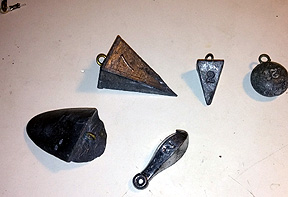
The third type of sinker I carry with me is the normal bank sinker. Bank sinkers are the ones that you would use on a pier or in a boat. They are round and don’t do very well in waves or current because they will move. The only time I use a bank sinker is on the bait rod. If I am trying to locate the bait I will let the waves/current move the rig around till I find what I am looking for. The last sinker that I have in my box when I am on the beach is what a lot of people call “sputnik” style sinkers. These are the ones that have 4 or 6 arms that extend out and help the sinker anchor into the sand. These are very similar to the sand anchors used in Pin Rigging off of a pier. The only issue with this style of sinker is a lot of the times they will get buried in the sand and present a challenge trying to get them “un stuck”. I only use these when I absolutely have to. For example when 10oz will not hold, I will try one of those sputniks.
The last subject that I want to discuss are the different knots that I use. This is one of those topics that I can go on for days talking about: all the different types of knots that are out there, which ones are better, etc. The biggest thing to remember is for you to use whatever knot you are comfortable tying and what you have confidence in. The second biggest thing is to practice the knots you plan on using, that way you are not wasting time trying to re-rig after a break off, especially if the bite is on fire, its dark, or your hands are wet (or all three!)
The knot I use to tie my main line to my shock leader is the basic Albright. My friend Dave uses a modified version. My buddy Alex uses the Uni to Uni. Other friends use other knots, including two guys that can tie a Bimini twist in less than a minute (pretty wild to see). The big thing to remember is you want something with a low profile so it can sail through your guides. I think we all know what happens when the shock knot stops during a cast… My point is find a knot, learn to tie it, and be confident in it. My buddy Alex does not like the Albright at all; he has had issues with them in the past. I on the other hand do like it, and use it all the time. Just like the shock knot, myself and most of my friends have a variety of other knots that they will use. Like I mentioned before, it’s all what you feel comfortable tying and what you have confidence in. When I originally wrote this I wanted to have pictures of all the different types of knots, but after some research, its easier to “Google” the knots instead. There are a lot of good tutorials online that show you step by step how to tie the knots.
I hope this write up has answered many of the questions you may have about rigging techniques.


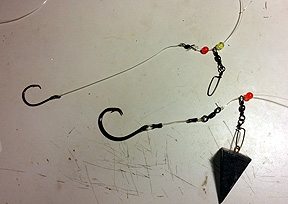
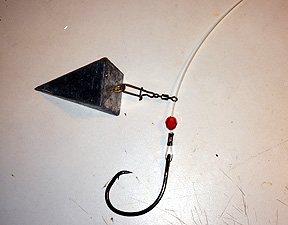
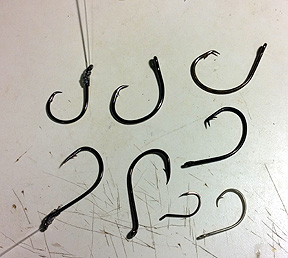
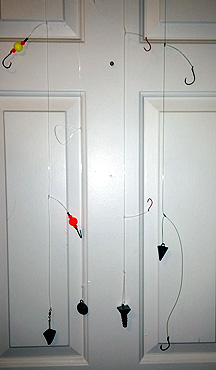


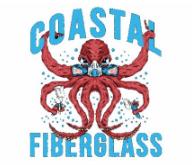

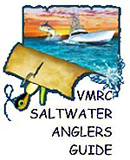




 Views Last 7 days : 1052
Views Last 7 days : 1052 Views Last 30 days : 7363
Views Last 30 days : 7363